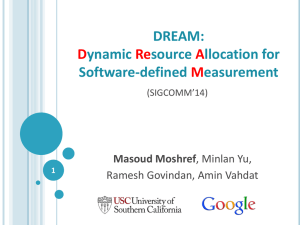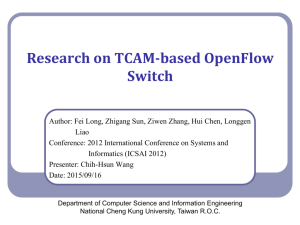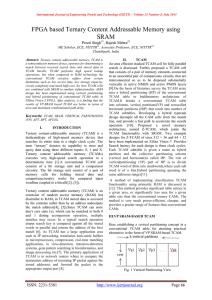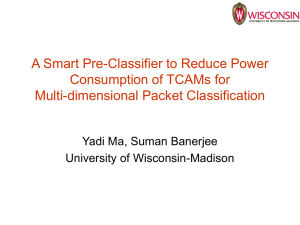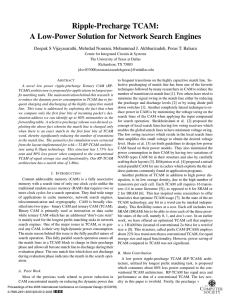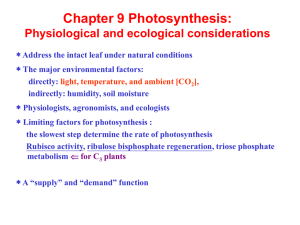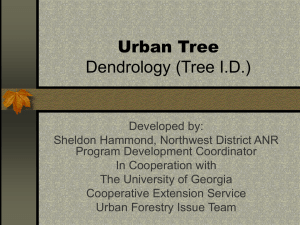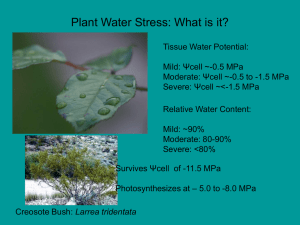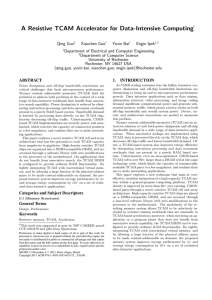Vamanan-TreeCAM
advertisement
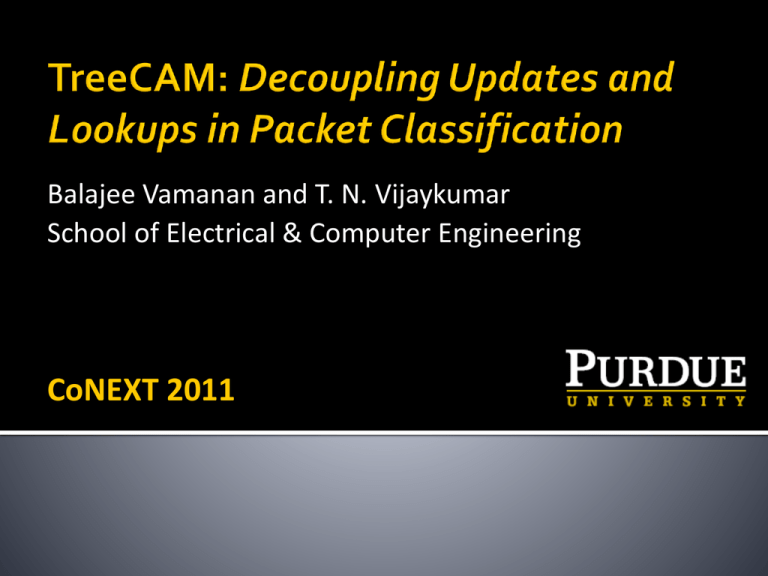
Balajee Vamanan and T. N. Vijaykumar School of Electrical & Computer Engineering CoNEXT 2011 Packet Classification: Find highest-priority rule that matches a packet Packet classification is key for Security, traffic monitoring/analysis, QoS Classifier: a set of rules Source IP Destination Source IP Port 120…0/24 198...0/2 138…1/0 174…0/8 0:65535 50:10000 Dest. Port Protocol Action 11:17 0xFF/0xFF Accept 0:65535 0x06/0xFF Deny Packet classification prevalent in modern routers 2 Line rates increasing (40 Gbps now, 160 Gbps soon) Classifier size (number of rules) increasing Custom rules for VPNs, QoS Rules are getting more dynamic too Larger classifiers at faster lookup & update rates Much work on lookups, but not on updates Must perform well in lookups and updates at low power 3 Two flavors Virtual interfaces: add/remove 10,000s rules per minute QoS: update 10s of rules per flow (milliseconds) For either flavor, update rate (1/ms) << packet rate (1/ns) Current approaches Either incur high update effort despite low update rates ▪ Eat up memory bandwidth ▪ Hold-up memory for long ▪ packet drops, buffering complexity, missed deadlines Or do not address updates Recent OpenFlow, online classification faster updates Updates remain a key problem 4 TCAM Unoptimized TCAMs search all rules per lookup high power Modern partitioned TCAMs prune search reduce power ▪ Extended TCAMs [ICNP 2003] Physically order rules per priority for fast highest-priority match ▪ This ordering fundamentally affects update effort Updates move many rules to maintain order ▪ E.g., updates 10 per ms; lookups 1 per 10 ns; 100,000 rules ▪ If 10 % updates move (read+write) 10 % rules ▪ Updates need 20,000 ops/ms = 0.2 op per 10 ns ▪ 20% bandwidth overhead High-effort updates in TCAM degrade throughput & latency 5 Decision Trees: Build decision trees to prune search per lookup Do not address updates No ordering like TCAMs but updates may cause tree imbalance ▪ Imbalance increase lookup accesses ▪ Re-balancing is costly Previous schemes are not good in both lookups and updates 6 TreeCAM: Three novel ideas Dual tree versions to decouple lookups and updates ▪ coarse tree in TCAM reduce lookup accesses ▪ Tree/TCAM hybrid ▪ fine tree in control memory reduce update effort Interleaved layout of leaves to cut ordering effort Path-by-path updates to avoid hold-up of memory ▪ Allow non-atomic updates interspersed with lookups Performs well in lookups and updates 6-8 TCAM accesses for lookups Close to ideal TCAM for updates 7 Introduction Background: Decision Trees Dual tree versions ▪ ▪ Coarse Tree Fine Tree Updates using Interleaved Layout Path-by-path updates Results Conclusion 8 Rules are hypercubes in rule space Builds decision tree by cutting rule space to separate rules into smaller subspaces (child nodes) Stop when a small number of rules at a leaf called binth (e.g., 16) Packets traverse tree during classification Y X Root Many heuristics Dimension, number of cuts 9 Introduction Background: Decision Trees Dual tree versions ▪ ▪ Coarse Tree Fine Tree Updates using Interleaved Layout Path-by-path updates Results Conclusion 10 Idea: partition rules among TCAM subarrays using decision trees 4k-entry subarrays coarse tree with each leaf in a subarray 2-deep tree fast lookup Packets traverse subarrays Previous heuristics complicated We propose simple sort heuristic Sort rules & cut equally ▪ EffiCuts min. rule replication Coarse Trees Search Pruning (trees) + Parallel Search (TCAM) Y X Root Leaf1 Subarray 1 Rootot Leaf 1 Subarray 2 Leaf 2 Subarray 3 Leaf 2 TCAM 11 Key observation: A packet cannot match multiple leaves only rules within the same leaf need ordering Reduce update effort Tree with small binth – fine tree ▪ Not real, just annotations ▪ One coarse-tree leaf contains some contiguous fine-tree leaves ▪ Both trees kept consistent Y X Root Updates slow store fine tree in control memory Fine Trees: Small binth, reduced ordering effort in TCAM 12 Introduction Background: Decision Trees Dual tree versions ▪ ▪ Coarse Tree Fine Tree Updates using Interleaved Layout Path-by-path updates Results Conclusion 13 Add a rule Root Create empty space at right priority level via repeated swaps 1 Leaf 1 With naïve, contiguous Priority 1 layout of leaves, requires 2 many repeated swaps ▪ As many swaps as #rules Observation: Only overlapping rules need ordering per priority Too hard in full generality Leaf 2 1 3 2 1 3 2 . 3 Empty Entries 14 Insight: Leaves are naturally nonoverlapping only rules in a leaf need to be ordered Root Trivial unlike general overlap Leaf 1 Interleave rules across all leaves Priority Contiguously place same priority- 1 level rules from all leaves 1 2 Order only across priority levels 2 Move at most one rule per level 3 ▪ binth levels small for fine tree 3. Leaf 2 ▪ Update effort ≈ binth swaps Empty Entries 15 Paper breaks down into detailed cases Worst case where rules move across TCAM subarrays Interleaved layout effort ≈ 3*binth *#subarrays swaps ▪ ≈ 3*8*25 ≈ 600 swaps (100K rules and 4K rules/subarray) Contiguous layout effort ≈ #rules ▪ ≈ 100K swaps (100K rules) Details in the paper 16 Problem: Update moves hold up memory for long Make updates non-atomic Packet lookups can be interspersed between updates Details in the paper 17 Introduction Background: Decision Trees Dual tree versions ▪ ▪ Coarse Tree Fine Tree Updates using Interleaved Layout Path-by-path updates Results Conclusion 18 Key metrics: Lookups & Updates Lookup accesses: #accesses per packet match Update effort: #accesses per one-rule addition Software simulator EffiCuts, TCAM, and TreeCAM TCAM: Unoptimized & Partitioned TCAM (Extended TCAM) ▪ 4K subarrays Decision tree algorithm (EffiCuts) Tree/TCAM hybrid (TreeCAM) ▪ Coarse tree binth = 4K, Fine tree binth = 8 ClassBench generated classifiers – ACL, FW and IPC 19 Accesses per Lookup 120 EffiCuts Unopt. TCAM Extended TCAM TreeCAM 100 80 60 40 20 0 10K 100K ACL 10K 100K FW 10K 100K IPC EffiCuts require many more SRAM accesses than TCAMs Extended TCAM and TreeCAM require only at most 8 accesses even for 100,000 rule classifiers Extended TCAM does not handle updates 20 Compare TCAM-basic, TCAM-ideal and TreeCAM EffiCuts and Extended TCAM do not discuss updates TCAM-basic: periodic empty entries TCAM-Ideal: Adapt existing work on longest prefix match for packet classification Identify groups of overlapping rules, and ideally assume ▪ Enough empty entries at the end of every group ▪ Two groups of overlapping rules DO NOT merge (ideal) We generate worst case update stream for each scheme Details in the paper 21 Classifier Size Classifier Type ACL FW IPC TCAM-basic Empty Max # Slots TCAM Ops TCAM-ideal Max. Overlaps Max # TCAM Ops TreeCAM #SubMax # arrays TCAM Ops 10K 44K 30K 67 134 3 91 100K 60K 276K 166 332 19 684 10K 68K 64K 90 180 3 112 100K 82K 567K 295 590 29 1069 10K 43K 22K 62 124 1 24 100K 46K 236K 137 274 11 385 TreeCAM is close to Ideal and two orders of magnitude better than TCAM-basic 22 Previous schemes do not perform well in both lookups and updates TreeCAM uses three techniques to address this challenge: Dual tree versions: Decouples lookups and updates ▪ Coarse trees for lookups and fine trees for updates Interleaved layout bounds the update effort Path-by-path update enables non-atomic updates which can be interspersed with packet lookups TreeCAM achieves 6 – 8 lookup accesses and close to ideal TCAM for updates, even for large classifiers (100K rules) TreeCAM scales well with classifier size, line rate, and update rate 23
